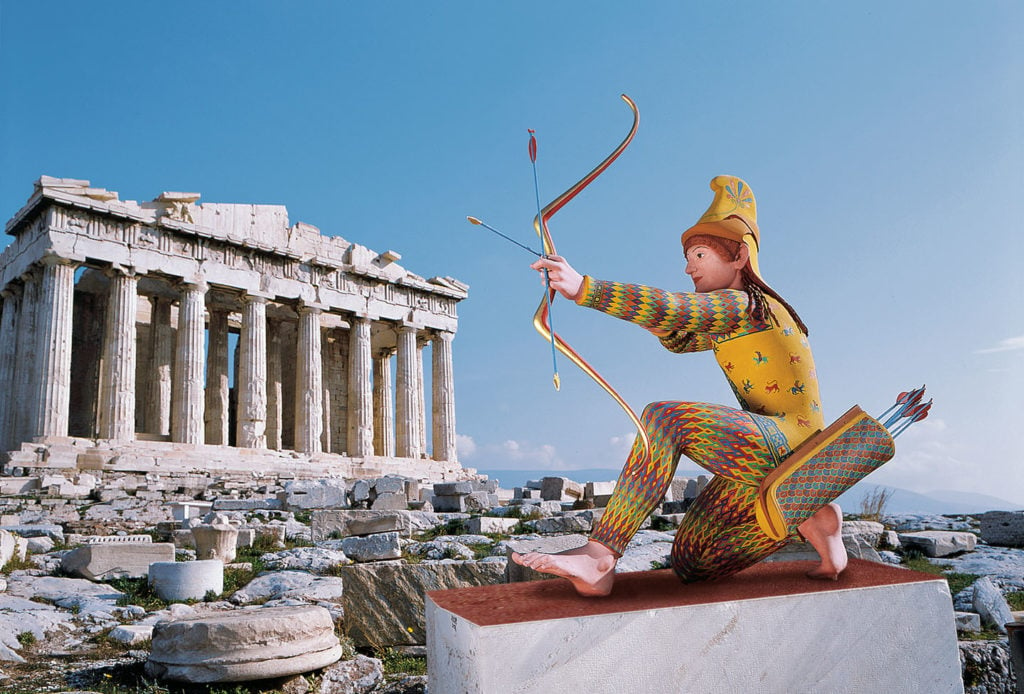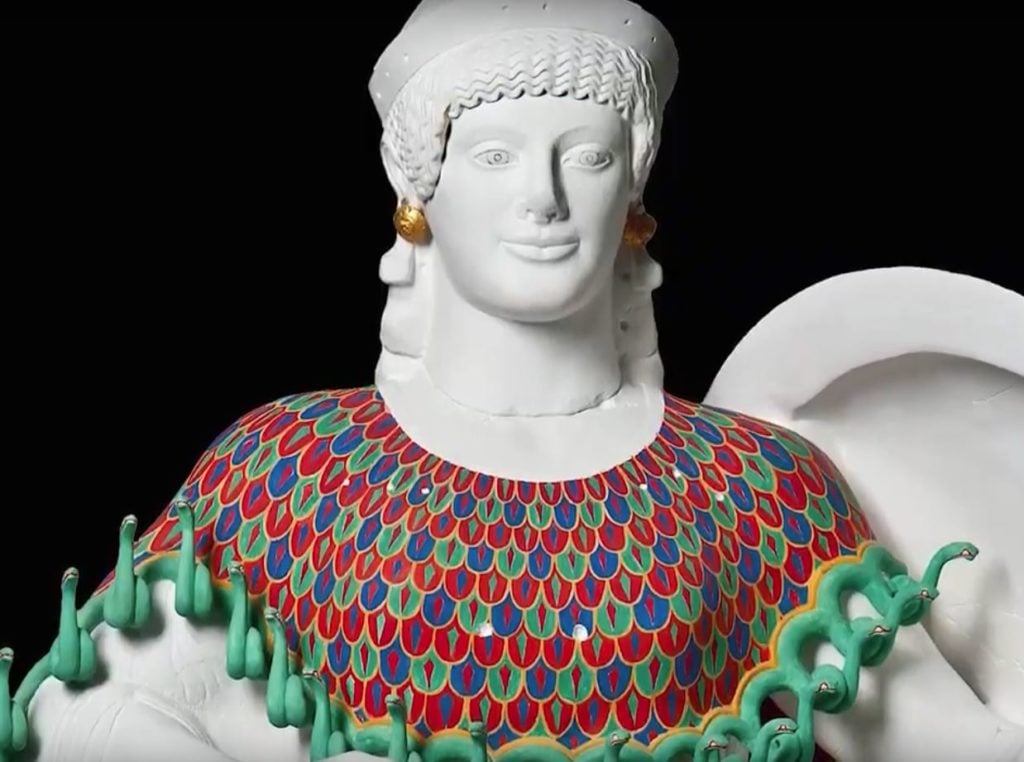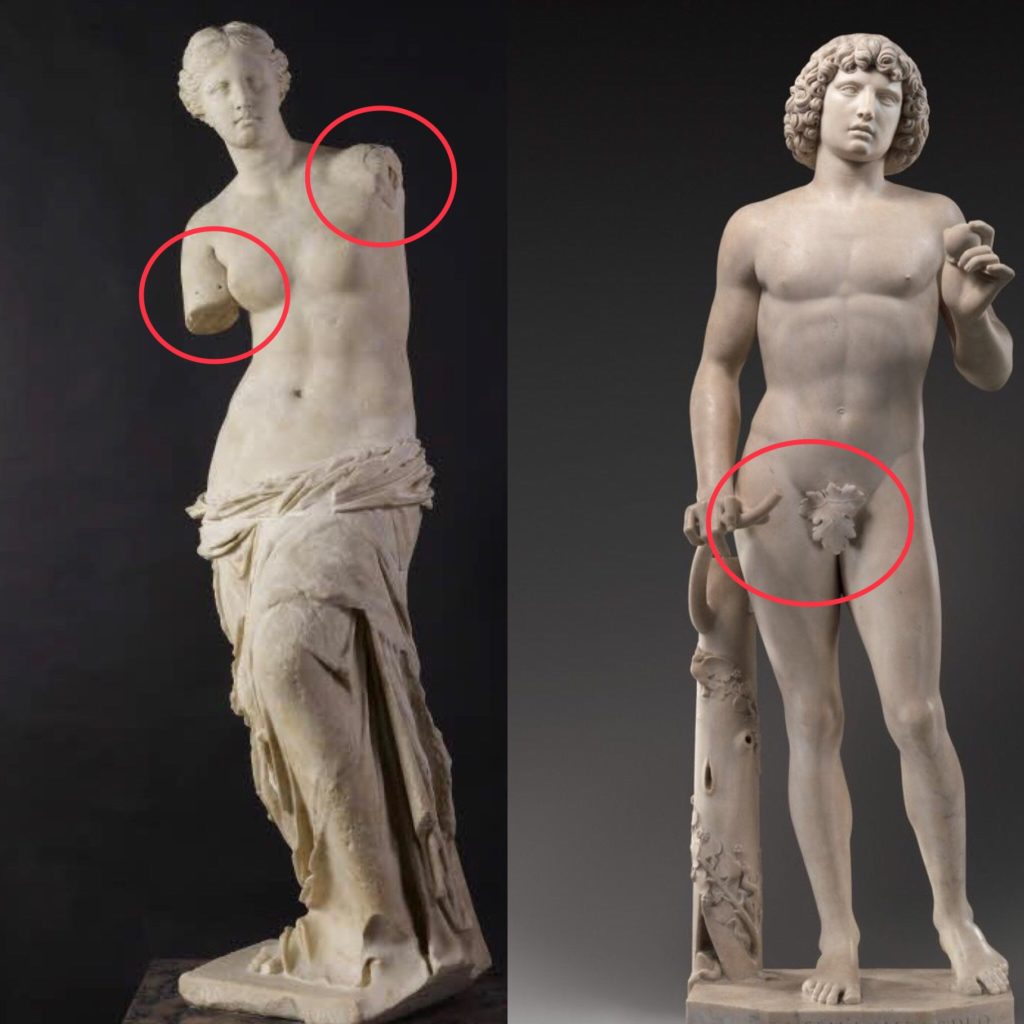Art World
These 7 Ancient Artworks Have Been Ravaged by Time—and Now Look Radically Different From How They Once Did
We haven't seen these works the way they were meant to be seen.

We haven't seen these works the way they were meant to be seen.

Andrew Nunes

We’re used to revering the past; it seems natural. Yet due to the entropic nature of time, many of the ancient works of art and architecture we hold in such high regard look entirely different today than they did centuries ago. Classical statues, for example, used to be painted. But they’re not the only things that no longer appear as they used to. Below are seven ancient remnants that looked completely different when they were first made.

An example of how brightly colored classical statues may have looked. Courtesy of “Coloring the Past,” Vinzenz Brinkmann and Ulrike Koch-Brinkmann.
1. Classical Sculptures
Since at least the 18th century, the cream-colored marble surfaces of classical Greek and Roman statues have been revered as symbols of refined taste and elegance, and have been considered to possess a sort of timeless, minimalist quality.
Yet curiously, the highly idealized off-white surfaces of these sculptures have turned out to be something of a lie. In the 1980s, German classical archaeologist Vinzenz Brinkmann learned that, upon close observation with a specially made lamp, many classical sculptures in fact still had slight marks of color, heavily faded to the point of illusory disappearance over the years.
Years after his discovery, Brinkmann (alongside his wife, the archaeologist Ulrike Koch-Brinkmann) began to recreate surviving classical sculptures, making sure to add saturated versions of the faint colors discovered on the surfaces of the originals, allowing others to finally glimpse the classical works as they were originally intended to appear.

A typical page from the Archimedes Palimpsest. The text of the prayer book is seen from top to bottom. The original Archimedes manuscript is seen as fainter text below it, running from left to right. Courtesy of Wikimedia Commons.
In the 13th century, the Archimedes Palimpsest (a 10th century Byzantine-Greek document), was damaged by religious fanatics who overwrote the codex with Christian writings. Though marred, most of the original text (which was a copy of an otherwise unknown work by ancient Greek scientist Archimedes) remained intact—though this would not prove to be the end of the Palimpsest’s perils.
Centuries later, in the 1920s, the manuscript—which had been housed in the Greek Orthodox Patriarchate of Jerusalem’s library in Constantinople—went missing. Years later, after a series of shady transactions, it was discovered that a forger had inserted medieval-style evangelical portraits in gold leaf into the codex to increase its black-market value—nearly obliterating the underlying text.

Left: The colors we’re used to seeing in Egyptian decorations. Right: What the colors may have looked like when such works were first made. Images courtesy Wikimedia Commons.
Like Greek and Roman sculptures, the various monuments, hieroglyphs, and other decorations in ancient Egyptian temples were not as visually washed-out as their appearances today suggest.
The varying tones of beige most commonly associated with ancient Egyptian art are the result of hue deterioration from inclement weather and the simple passage of time. The works, in fact, were originally painted with a wide spectrum of colors, from vivid blues and reds to rarer mixed colors like purple and green. Unlike classical Greek sculptures, some of these Egyptian temple decorations retain visible colors, though many—like the Temple of Dendur at the Met—have not survived fully intact.

The Antikythera mechanism in its corroded state and a modern replica. Courtesy of Wikimedia Commons.
Uncovered from a shipwreck off the Greek island of Antikythera in 1901, the aptly named Antikythera mechanism is a heavily corroded set of mechanical gears that could have easily been disregarded as rubble by the divers who came upon it, given the plentiful artifacts and jewelry that were also part of their haul.
Though it was brought to the National Museum of Archaeology in Athens, the mystery as to what purpose the mechanism served was unsolved until 1959, when English physicist Derek De Solla Price completed an 8-year x-ray study of the relic. He subsequently reached the conclusion that it was a sort of analog computer—clearly one of the earliest in history—that functioned as an astronomical clock to predict eclipses and serve astrological purposes.
Despite its worn-out appearance, archaeologists have been able to create replicas of what it may have looked like before its decay. Mostly, it resembles ornate clockwork—which would have been impossible to imagine based on what was originally found in the sea.

Screenshot footage of archaeologists in the caves, where there are no wall paintings to be seen. Courtesy of YouTube.
Near the unassuming village of Bruniquel in southern France lies the Meyrieres Cave, a prehistoric painting site adorned with two notable ancient paintings of bison. Lamentably defaced by graffiti in 1992, the paintings were cleaned up by a local youth group sent to tackle the task—and their work would turned out only to damage the painting even more.
Accidentally wiping off part of the 15,000-year-old bison paintings (presumably confusing it with the graffiti they were tasked with cleaning), the group erased a large portion of the images, leading the naive students to become recipients of the parodical Ig Nobel Prize in Archeology for that year.

This model of the Temple of Artemis, at Miniatürk Park, Istanbul, Turkey, attempts to recreate the probable appearance of the first temple. Courtesy Wikimedia Commons.
The Temple of Artemis, originally located in the ancient Greek city of Ephesus (which has since become the Turkish town of Selçuk), exists only as a few crumbling pillars today, though this is perhaps the fourth iteration of the temple.
Initially constructed in the Bronze age, it was was destroyed by a flood in the 7th Century BC, before being rebuilt in 550 BC as a more monumental version that would be considered one of the Seven Wonders of the Ancient World. Yet this temple would be cursed to destruction too, suffering an act of arson in 356 BC.
Rebuilt again in even more bombastic form around 323 BC, this final documented version would be ransacked by the Goths in 268 AD, though supposedly repaired in later, less-documented years, before being closed due to pagan persecution. Though the exact circumstances are unknown, the temple was finally left to crumble until reaching the depleted state it exists in today.

Left, Alexandros of Antioch, Venus de Milo (130 BC). Courtesy of the Musee de Louvre. Right, Tullio Lombardo, Adam (ca. 1490–95). The Metropolitan Museum of Art.
You’ve seen them in museums: many classical Greek and Roman sculptures that line the halls of some of our finest institutions are clearly dispossessed of body parts, often with craggy ends delineating some rupture.
Though some of these works—like the iconically armless Venus de Milo statue—are still shrouded in mystery (was the statue intended as a depiction of a prostitute?), there is a specific type of dismemberment that traces its lineage to the pre-Enlightenment-era Catholic Church.
Many statues of men with their genitals covered by fig leaves (in some cases, their peters were simply broken off) can be attributed to a 16th-century Catholic movement dubbed “the fig leaf campaign,” which aimed to dispossess these statues of their sinful “lust” in accordance with new guidelines imposed by the Council of Trent.